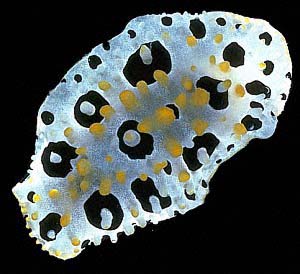
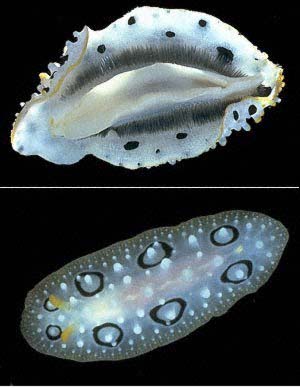
Phyllidia babai
Brunckhorst, 1993
Order: NUDIBRANCHIA
Suborder: DORIDINA
Family: Phyllidiidae
DISTRIBUTION
Known from north-eastern Australia (Great Barrier Reef) and Papua New Guinea.
PHOTO
UPPER, MIDDLE: 18 m depth, North Point Reef, Lizard Island, GBR, 20 Nov. 1981, dorsal and ventral views respectively of 43 mm specimen, PHOTOS: Bill Rudman (Brunckhorst, 1993: Plate 3G,H);
LOWER: 12 m depth, sunken barrier reef, south-east of Port Moresby, PNG 20 Apr. 1984, dorsal view of 27 mm specimen, Photo: C. Carlson & P. Hoff (Brunckhorst, 1993: Plate 4A).
Notes compiled from Brunckhorst, 1993:
Phyllidia babai is closest to Phyllidia ocellata, but the two are distinct species. The characteristic features of P. babai include: the very pale yellow to cream dorsum; black rings with a central, white, conical tubercle; the fine yellow edge to the mantle; rhinophoral clavus possessing 21-24 lamellae; the rim of the rhinophoral pocket edged in white; pale cream-white ventral coloration; white pointed oral tentacles tipped in yellow with long lateral grooves. In contrast, P. ocellata possesses, a bright gold coloured dorsum with black patches bordered in white, and gold or white rounded tubercles, no contrasting colour on the mantle edge or rim of the rhinophoral pockets, 27-30 lamellae to the rhinophoral clavus, dark grey ventral coloration, dark grey oral tentacles with rounded ends tipped in yellow and short lateral grooves.
Phyllidia exquisita and Phyllidia willani are similar to the present species as they all have pale background coloration. P. exquisita has a yellow mantle margin but possesses longitudinal black and white areas and rounded tubercles. Unlike P. babai, P. willani has a granular, pale yellow dorsum with black lateral swirls and no yellow on the mantle margin.
Reference:
• Brunckhorst, D.J. (1993) The systematics and phylogeny of Phyllidiid Nudibranchs (Doridoidea). Records of the Australian Museum, Supplement 16: 1-107.
Rudman, W.B., 1999 (January 12) Phyllidia babai Brunckhorst, 1993. [In] Sea Slug Forum. Australian Museum, Sydney. Available from http://www.seaslugforum.net/find/phylbaba
Related messages
Phyllidia babai? from North Sulawesi
August 20, 2008
From: Marli Wakeling
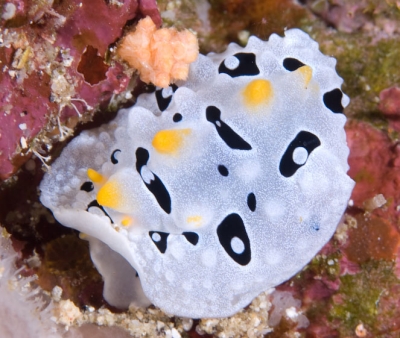
Hi Bill,
I think this is Phyllidia babai. It was found on the same site as the other mystery Phyllidia I sent in [message #21800], but has more typical colouration of P. babai, with the black rings.
Locality: Bunaken Marine Park, 40 feet, Sulawesi, Indonesia, Indo-Pacific, 22 July 2008, Wall. Length: 20 mm. Photographer: Marli Wakeling.
Cheers,
Marli
scubamarli@gmail.com
Wakeling, M., 2008 (Aug 20) Phyllidia babai? from North Sulawesi. [Message in] Sea Slug Forum. Australian Museum, Sydney. Available from http://www.seaslugforum.net/find/21802Dear Marli,
My comments in your earlier message [#21800] are equally relevant to this message. As you say this best fits P. babai, but I suspect P. willani, P. exquisita and P. babai are white forms of P. ocellata.
Best wishes,
Bill Rudman
Phyllidia babai or P. ocellata ?
June 6, 2007
From: Wyatt Ang
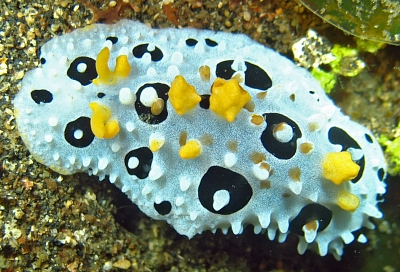
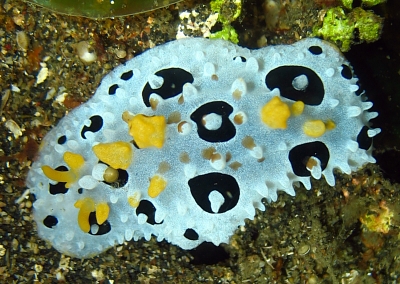
Dear Bill,
Please help me solve the mystery of the animal I captured. It perfectly fits the description of a Phyllidia babai but I saw a similar colour form mating with a P. ocellata on your Forum [message #5458 ]. If they are indeed 2 different species, how do we tell them apart?
Locality: Lembeh Strait, 6m, Indonesia, Mollucca Sea, 13 November 2006, Coral rubble, Silty, black volcanic sand. Length: 8 cm. Photographer: Wyatt Ang.
Thanks and regards
Wyatt
wyattang@gmail.com
Ang, W.L, 2007 (Jun 6) Phyllidia babai or P. ocellata ? . [Message in] Sea Slug Forum. Australian Museum, Sydney. Available from http://www.seaslugforum.net/find/19211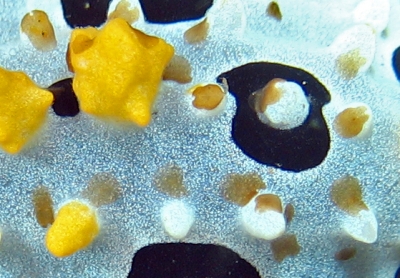
Good question Wyatt,
That's what I asked in the same message [#5458 ]. I am afraid sometimes new species are named without a good appreciation of colour variation within existing species. Websites like the Forum are giving us the opportunity to accumulate more information on colour variability than we ever have had before. Although we can't do without specimens for the study and comparison of anatomical differences, photos are giving us, for the first time, a way to see where problems in identity may exist. At this stage I would call your animal P. babai, although that species is most probably just a white form of P. ocellata.
I have included a close-up alongside to show your animal is infested with little brown acoelate flatworms.
Best wishes,
Bill Rudman
Phyllidia babai from Lembeh Strait
May 29, 2007
From: Mike Krampf
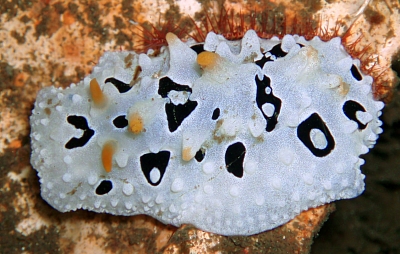
Dear Bill
You don't have many records of Phyllidia babai on the Forum so thought I'd share this picture for your database.
Locality: DIve Site - Mawali Wreck, 80 ft, Lembeh Strait, Indonesia, Celebes Sea, 27 October 2006, Wreck. Length: 3 cm. Photographer: Mike Krampf.
Mike
mtkrampf@yahoo.com
Krampf, M., 2007 (May 29) Phyllidia babai from Lembeh Strait. [Message in] Sea Slug Forum. Australian Museum, Sydney. Available from http://www.seaslugforum.net/find/18880Thanks Mike,
Best wishes,
Bill Rudman
Phyllidia babai found in Southern Queensland, Australia
February 24, 2005
From: Gary Cobb
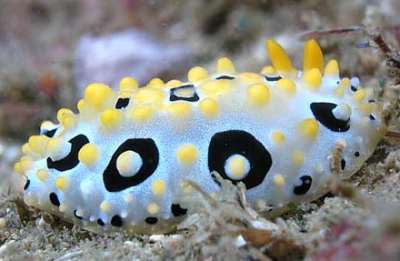
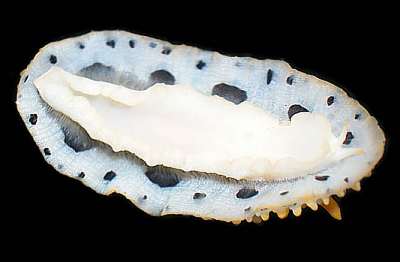
Hi Bill,
I thought you and the viewers might like to see our recent find here on the Sunshine Coast, off Mooloolaba, Queensland, Australia. While diving The Trench at 18m depth we found two Phyllidia babai, both critters were 35 and 40 mm long. The opaque white spots are a give away. In all the material I have read, the is no mention of yellow capped tubercles. The mantle edge is yellow and there is a crossed hatch pattern on the hyponotum.
Which brings to mind the issue of Global Warming (GW). We have found quite a few tropical animals here on the Coast recently and I think it is because of GW, what do you think?.
Locality: Mooloolaba, Sunshine Coast, Queensland, Australia. Depth: 18 m. Length: 35-40 mm. 19 February 2005. Small ledge on wall with reef. Photographer: Gary Cobb.
Our species list here on the Coast is currently 189. Our website is http://www.nudibranch.com.au
Cheers
Gary Cobb
gary@nudibranch.com.au
Cobb, G., 2005 (Feb 24) Phyllidia babai found in Southern Queensland, Australia. [Message in] Sea Slug Forum. Australian Museum, Sydney. Available from http://www.seaslugforum.net/find/13200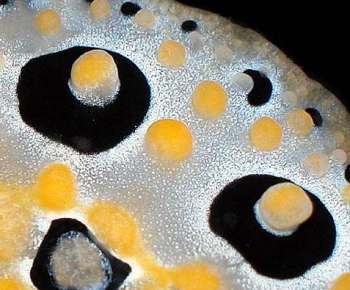
Dear Gary,
Thanks for the record. There is a photo of mine on the species Fact Sheet of an animal with yellow tubercles which Brunckhorst used in his monograph, so yellow tubercles are certainly part of Brunckhorst's species concept. I personally am still in two minds about whether all these are colour forms of Phyllidia ocellata.
Sorry I haven't updated the website links page on the Forum as yet but it is part of the Forum revamp I am waiting for some action on. I can't get into it at the moment but as soon as I can I will make some necessary additions and changes.
Best wishes,
Bill Rudman
Phyllidia babai from Sth Korea
December 10, 2003
From: Dong Bum Koh
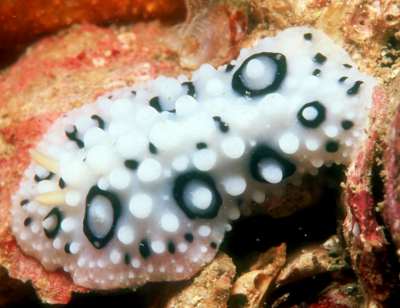
Dear Bill,
Here is a photo of Phyllidia babai. I have seen this animal only two times diving in Jeju area. Could you give me more information?
Thank you very much for your great help.
23 Nov. 2003
Moon islet, Jeju island, Sth Korea.
16 m depth.
Photo by Dong Bum Koh
Best regards,
Dong Bum Koh
drkoh@seasee.co.kr
Koh, D.B., 2003 (Dec 10) Phyllidia babai from Sth Korea. [Message in] Sea Slug Forum. Australian Museum, Sydney. Available from http://www.seaslugforum.net/find/11623Dear Dong Bum,
This certainly fits the description of Phyllidia babai. However I still wonder whether this is just a colour form of the highly variable Phyllidia ocellata in which the yellow background colour is absent
Best wishes
Bill Rudman
Phyllidia babai from Sulawesi
May 21, 2001
From: H. & M. Schirmböck
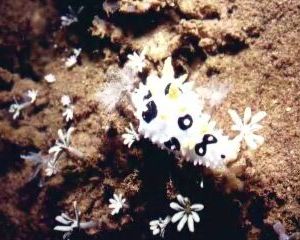
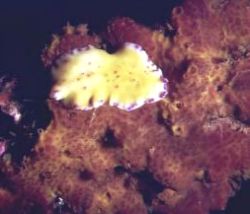
We are a diving couple and slug photographers, but only for private fun. We need identification help for the enclosed slug pictures taken in Sulawesi/Bunaken [Indonesia]
Helmut & Monika Schirmböck
Hanakgasse 16
2103 Langenzersdorf
Austria
schirmis@aon.at
Schirmböck, H.& M., 2001 (May 21) Phyllidia babai from Sulawesi. [Message in] Sea Slug Forum. Australian Museum, Sydney. Available from http://www.seaslugforum.net/find/4308Dear Helmut & Monika,
Your slug in the upper photo is Phyllidia babai. I wondered why you had named the image file 'edelweisschnecke' [edelweiss snail] until I saw the flower-like algae it was crawling past.
Your other photo is of a flatworm. Have a look at Wolfgang Seifarth's Marine Flatworms of the World at http://www.rzuser.uni-heidelberg.de/~bu6/index.html.
Best wishes,
Bill Rudman
